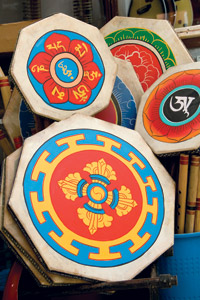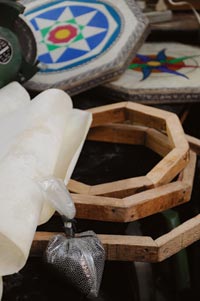Some stories get told and retold so many times, they almost seem mythical by the time they hit your ears and eyes. Stories and theirs origin can vary from one person to the other adding intrigue. And there are plenty of those in our fair land, perhaps none more captivating than the tale of Ocean Sound.
 But first and foremost, what is Ocean Sound? Its structure is similar to that of the Indian daffali, however the former has an octagonal shape. It is primarily goat-skin wound tightly on to a wooden frame so the skin sheath creates a sound when striking it. It is adorned with paintings of various gods and deities to sort of boost its aesthetic and heritage numbers. But it is not merely to be admired for the artwork or to be used as a musical instrument. What makes it completely different from its Indian counterpart are the small iron pellets in the hundreds in between the goat-skin and the wooden frame. These little entrapments complete the goal of the instrument and give it, its name. Now someone who has visited the beach should know of conches producing the sound of waves if you place your ears at its opening. Well, when you hold our instrument in your hand and slowly tilt it from side to side, the iron pellets strike one another and create the wonderful illusion of hearing the sounds of the ocean too! Vouching from first-hand experience, this writer can tell you if you close your eyes next to it, you’re not in a landlocked country anymore.
But first and foremost, what is Ocean Sound? Its structure is similar to that of the Indian daffali, however the former has an octagonal shape. It is primarily goat-skin wound tightly on to a wooden frame so the skin sheath creates a sound when striking it. It is adorned with paintings of various gods and deities to sort of boost its aesthetic and heritage numbers. But it is not merely to be admired for the artwork or to be used as a musical instrument. What makes it completely different from its Indian counterpart are the small iron pellets in the hundreds in between the goat-skin and the wooden frame. These little entrapments complete the goal of the instrument and give it, its name. Now someone who has visited the beach should know of conches producing the sound of waves if you place your ears at its opening. Well, when you hold our instrument in your hand and slowly tilt it from side to side, the iron pellets strike one another and create the wonderful illusion of hearing the sounds of the ocean too! Vouching from first-hand experience, this writer can tell you if you close your eyes next to it, you’re not in a landlocked country anymore.
The dates concerning the origins of the instrument are something that have been tossed around and discussed often times. Saroj Kulu of Saroj Instrumental Shop who has been making and selling them for 15 years now, tells of the true making of these go back some 40 years: “It was talked about being available for a long time. The version of the story that is more prevalent says it was inspired by a German Harp Maker Elna Marie. She was a frequent traveler and a musician and on one of her visits to Nepal some 20 years ago, she met a craftsman by the name of Hari. This man had modest skills in making instruments and during conversations she shared with him the designs for what would be later called Ocean Sound. Where she had heard about it and how where they made is a mystery, but she had knowledge about it and explained to Hari how it was to be built. It seemed simple enough to him and Hari not only made it but started selling it as well. It was such a novel item to so many buyers that they kept coming back for more. It was something that captivated the imaginations of whoever bought it and showed it to others. Initially it was something of a trade secret here and truly speaking only few Nepalis know of this instrument.”
 A little smile spread across his face. “It sounds like a mystical tale, no?” That would be true. If speaking from experience can be evidence, well here it is, I was rightly amazed at the first sight of this some seven years ago. In all the travels to various places in and around the valley looking at a plethora of handicraft items, nowhere had I come across such a novelty. It was also during its boom period that I stumbled upon it. The shop was thus decorated with a variety of these in a myriad of shapes and sizes. It was Saroj Kulu himself who introduced these to me and spoke then of how they work and how well their export business was doing. In sheer excitement, a video and many snaps were taken to be showcased as to what a marvel it was. Sadly, there was no Facebook to showcase it then. The question of ‘so what do you get in Nepal?’ remained. Many a friend who would visited Nepal would be shown the item and some even took it back to their lands as souvenirs.
A little smile spread across his face. “It sounds like a mystical tale, no?” That would be true. If speaking from experience can be evidence, well here it is, I was rightly amazed at the first sight of this some seven years ago. In all the travels to various places in and around the valley looking at a plethora of handicraft items, nowhere had I come across such a novelty. It was also during its boom period that I stumbled upon it. The shop was thus decorated with a variety of these in a myriad of shapes and sizes. It was Saroj Kulu himself who introduced these to me and spoke then of how they work and how well their export business was doing. In sheer excitement, a video and many snaps were taken to be showcased as to what a marvel it was. Sadly, there was no Facebook to showcase it then. The question of ‘so what do you get in Nepal?’ remained. Many a friend who would visited Nepal would be shown the item and some even took it back to their lands as souvenirs.
Adarsh Jabs of Nepal De Exports spoke of how his first encounter was equally amazing. “Working on one of the orders we had a few shipments of Ocean
 Sound as well. I had never seen them before and the first time I came across one it was almost magical. I couldn’t believe something like this was made here! A lot of these are proponents for Buddhism due to the Buddhist art they are adorned with on top, so a lot of people send these to monasteries as well. The artwork is immaculately done as well. We can find Hindu and Buddhist relics and symbols painted on them these days. It used to be a very good seller,” shares Adarsh.
Sound as well. I had never seen them before and the first time I came across one it was almost magical. I couldn’t believe something like this was made here! A lot of these are proponents for Buddhism due to the Buddhist art they are adorned with on top, so a lot of people send these to monasteries as well. The artwork is immaculately done as well. We can find Hindu and Buddhist relics and symbols painted on them these days. It used to be a very good seller,” shares Adarsh.
It certainly has been a big hit over the years as an item of export. Saroj Kulu explains: “The craze and I mean the craze was some 5-6 years ago. The sales to Europe and America were fantastic. And if I may add Germany was a huge buyer too. We did so many ranges and in such sheer numbers! It was great! A large Ocean Sound sold for around 950 rupees; the smaller ones went for 450 rupees. However due to the obvious inflation in the raw materials needed: wood, skin and almost everything else, the prices have gone up to 1200 rupees and 600 rupees respectively.” It is also worth noting that these became so popular that these were being made available in America in oval shapes and with a transparent, fiber-skin. These were not from Nepal though but imitation is the sincerest form of flattery. The market eventually got saturated and like the rise and fall of any trend, its sales too slowly burned out after the initial scramble. It still boasts of modest sales and newcomers still stand transfixed for a few seconds when they put it to their ears.
The charm and appeal of Ocean Sound remains. It is one of the most unique mementos that one could give to someone new to Nepal’s culture and heritage. There are no oceans we can boast of but it was something of an idea that was refined and perfected here. The mirage of decibels that it creates is nothing short of teleportation. It may very well have been nothing more than a fleeting thought in a foreigner’s mind but the way it was redefined here makes it our own. And so it shall stay, if only, more of us knew.











